WMG News
Warwick University will help Bolivia become the “energy cell of the world”
Historic agreement sees the university and Bolivia collaborate on lithium battery project and provide scholarships for Bolivian students
The University of Warwick is set to help Bolivia become a world leader in renewable energies and electric vehicles, thanks to a historic partnership on lithium battery research with the Bolivian Government.
The partnership, funded by the UK’s Foreign Commonwealth & Development Office (FCDO), will help develop lithium’s application as a power source in everything from electric cars to mobile phones.
Bolivia’s vast salt flats harbour an estimated 39 million tonnes of lithium reserve, positioning the country to be one of the world’s most important suppliers in the coming decades. The projects supports Bolivia’s ambition to provide 40% of the world’s supply of lithium by 2030. It will see Bolivia be at the forefront of lithium value chain, lead to higher paying employment and industry and a transition away from simple extraction and exploitation of raw materials.
Several master’s degree scholarships will also be offered to Bolivian students and the University’s WMG will link up with Yacimentos de Lito Bolivianos,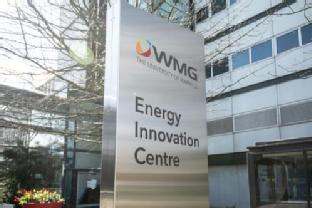 Bolivia’s lithium mining institution in a multi-year research project to improve the understanding and possibilities for lithium battery technology.
Bolivia’s lithium mining institution in a multi-year research project to improve the understanding and possibilities for lithium battery technology.
David Rutley, Minister for the Americas and Caribbean at FCDO was present at the signing of the agreement and said: “This is a landmark partnership between Bolivia and Warwick – one of our great UK universities. This collaboration will help unlock the possibilities of battery technology in a new era of clean energy. The partnership will also address the drawbacks associated with using fresh water in the extraction process – making the industry more sustainable and less environmentally damaging.”
“This agreement demonstrates the potential for scientific and technological cooperation of our two great nations. It could help see Bolivia become the energy cell of the world.”
Professor Mike Shipman, University of Warwick’s Pro-Vice- Chancellor (International), said: “We are excited to be partnering with the Ministry of Hydrocarbons and Energies and Yacimentos de Litio Bolivanos. This collaboration will draw on the University’s extensive expertise in battery technologies and build new capabilities in Bolivia and help the global transition to sustainable power solutions through innovative research and training”.
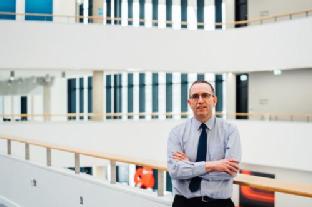 Professor Robin Clark, Dean of WMG at the University of Warwick said: “This opportunity is one that will help ensure WMG stays at the forefront of global battery research and education. It has been a pleasure to share our work with our Bolivian partners and we hope that this is the start of a long and productive relationship.”
Professor Robin Clark, Dean of WMG at the University of Warwick said: “This opportunity is one that will help ensure WMG stays at the forefront of global battery research and education. It has been a pleasure to share our work with our Bolivian partners and we hope that this is the start of a long and productive relationship.”
Notes to editors:
For more information contact Tania Corbett, Media Relations Manager at Warwick University: tania.corbett@warwick.ac.ukLink opens in a new windowLink opens in a new window | Mob: +44 (0) 7824 540 727. General and out of hours press office number 02476 151 512
Interviews available in Spanish and English.
The research project between Warwick/WMG and Bolivia’s Yacimentos de Lito Bolivianos YLB will focus of synthesis and characterization of battery cathode materials derived from lithium extracted from the Salar de Uyuni. The partnerships will combine expertise on battery manufacturing and characterization between the two groups. Access to the sources of lithium supplies is critical for the development of active materials within Li-ion battery and requires the UK to develop strategic partnerships internationally.
WMG in landmark battery development partnership
Researchers at WMG at the University of Warwick, are part of a unique four-way partnership, with Addionics, technology innovation catalyst CPI and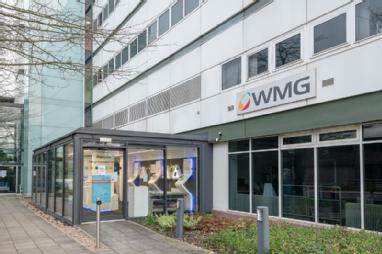 James Durrans Group, which will position the UK as a technology hub for global battery development.
James Durrans Group, which will position the UK as a technology hub for global battery development.
Project Constellation is an extension of Project STELLAR which focused on improving battery power and cycle life. Project Constellation takes the research to the next level addressing improvements to battery performance, which will in turn lower development and production costs.
The team at WMG will use its expertise in pilot scale electrode production, cell manufacturing and electrochemical testing to support and de-risk rapid technology screening and accelerate the route to market.
Farid Tariq Ph.D, CTO and Co-founder of Addionics, explains:" Constellation builds on the success of Stellar taking it beyond basic tests and towards industrially relevant scales. We are excited because it provides a strong integration piece of our technology with world leaders in coating and fabrication, and active material fabrication (WMG, CPI, James Durrans) that can show how our very smartly designed and structured current collectors can fit into a viable battery ecosystem and provide benefits from our technology. This is readily transferable knowledge and will push the creation of new methods to overcome modern limitations of batteries and fabrication."
Mark Copley, Chief Engineer in WMG at the University of Warwick’s Electrochemical Materials and Manufacturing team said: “WMG is delighted to be a partner in the CONSTELLATION consortium. Utilising our experience in scaling up new technologies, from lab to pilot line, we feel that we will be able to further the development of Addionics’ current collector technology whilst coupling in Durrans’ graphite and formulation developments, as derived by CPI.
“The project goals fit very well with the ideals of WMG, which is to work collaboratively with industry to deliver high-quality, applied, research and development. We look forward to the results that will be generated through this funded collaborative effort.
Project Constellation is a two year project, funded by the UK Government’s Faraday Institution’s Faraday Battery Challenge Round 5 Innovation.
About the partners
Addionics
Addionics is a next-generation battery technology company revolutionizing battery performance through its chemistry-agnostic Smart 3D Electrode architecture. The company’s scalable, cost-effective manufacturing process combined with its AI-based optimization software significantly improves the performance of any kind of chemistry, achieving batteries with higher energy density, faster charging, and longer lifetime, at low cost. With the mission to accelerate an electrified economy and decarbonized future, Addionics is unlocking the full potential and accelerating the electrification revolution through its drop-in solutions.
CPI
We take great ideas and inventions, and we make them a reality. Born in the North East of England in 2004, CPI is an independent deep tech innovation organisation and a founding member of the High Value Manufacturing Catapult.
We're a team of intelligent people using advances in science and technology to solve the biggest global challenges in healthcare and sustainability. Through our incredible people and innovation infrastructure, we collaborate with our partners in industry, academia, government, and the investment community to accelerate the development and commercialisation of innovative products.
Our work ranges from health technologies, advanced drug delivery systems, and medicines manufacturing innovations for multiple modalities including small molecules, biologics, and nucleic acids; to developing sustainable materials for energy storage and packaging, as well as novel food, feed, and nutraceuticals, that are all underpinned by digital technology. We turn the entrepreneurial spirit and radical thinking of our people and partners into incredible impact that makes our world a better place.
Let’s innovate together: uk-cpi.comLink opens in a new window
Connect with us: LinkedIn TwitterLink opens in a new window InstagramLink opens in a new window FacebookLink opens in a new window
James Durrans Group
Long established family owned manufacturing company (1863) based in Penistone near Sheffield but with manufacturing sites across the globe. We provide pro-active solutions to our customer needs. Experts in carbon processing and technology and the manufacture of heat resistant coatings and graphitic dispersions.
International accreditation for WMG’s Energy Innovation Centre
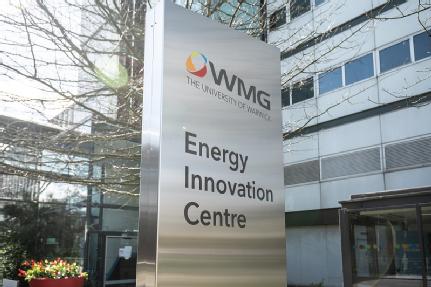 The Energy Innovation Centre (EIC) at WMG, University of Warwick has successfully achieved two key ISO Management Systems Standards (MSS).
The Energy Innovation Centre (EIC) at WMG, University of Warwick has successfully achieved two key ISO Management Systems Standards (MSS).
ISO Management Systems Standards set out requirements or guidance to help organisations manage policies and processes to achieve specific objectives and maintain high customer service. Each ISO has specific points of clarification.
The first MSS that the EIC was assessed against was ISO 9001 on Quality Management Systems. The audit covered the entire business operation within WMG’s battery research facilities, including the manufacture of battery cells and packs, testing of chemistries from degradation and performance through to full destructive testing.
The second standard ISO 14001 covers Environment Management Systems. This standard specifies the requirements for a sustainable management system that can be used to enhance environmental performance. This included a full assessment of how environmental risks are managed within the EIC.
The EIC was successful in achieving full certification of both standards.
Mark Amor-Segan, Chief Engineer based in the EIC at WMG, University of Warwick said: “We are one of the first university research groups to achieve this. This certification will align us with many of our industrial partners in terms of the fundamental principles of quality and environmental performance.
“Achieving this is a testament to the hard work from everyone within the EIC, and demonstrates our commitment to develop, implement and maintain an integrated quality and environmental management system (IMS) that meets the requirements of ISO 9001, ISO 14001 and our company, legal and other obligations.”
For a copy of the WMG Energy Innovation Centre IMS Combined Policy Statement contact: eic.support@warwick.ac.uk
The Energy Innovation Centre is a national facility, funded by the High Value Manufacturing Catapult (HVMC), for battery research across the R&D process from materials and electrochemistry through to application integration and recycling/re-use. The facilities support test, development and scale up of new battery chemistries from concept through to full proven traction batteries, produced in sufficient quantities for detailed industrial evaluation in target applications.
For more information or to arrange a tour of WMG’s facilities email wmgbusiness@warwick.ac.uk
Voi and Bumblebee Power partner on UK’s first wireless e-scooter charging trial launched at the University of Warwick
- Time-consuming and resource-intensive charging processes could be replaced by wireless charging for e-scooter rental fleets
- The ease of use for consumers and a reduction in operating costs through wider adoption of this technology would be a big advantage for the UK’s biggest rental scheme operator, Voi
- Trial in partnership with Bumblebee Power and WMG on the University of Warwick campus allows real-world testing in a ‘mini-city’ environment
- A successful trial will pave the way for seamless and convenient charging of e-scooters
Voi Technology, the UK’s largest e-scooter rental operator, has partnered with Bumblebee Power and WMG to trial the use of Bumblebee’s wireless e-scooter charging at the University of Warwick campus over a 6-month period potentially changing the future of the micromobility industry.
As with the charging of electric cars, the charging of e-scooters is a challenge for the operators of extensive rental schemes. The batteries powering their zero-emissions e-scooters are currently charged safely at their warehouse; however, they are replaced when vehicles are either receiving their regular in-house inspections or by the company’s in-field team who visit each e-scooter to perform fresh battery swaps.
These processes can lead to high operating costs for their business as the processes can be both time-consuming and often resource-intensive by requiring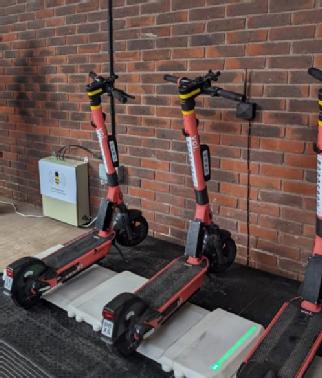 additional warehouse infrastructure for safe battery charging as well as transportation costs. Therefore, Voi began exploring new charging methodologies as a result that could provide the same excellent user experience whilst also delivering a similar vehicle efficient and effective battery performance. The potential solution: wireless charging.
additional warehouse infrastructure for safe battery charging as well as transportation costs. Therefore, Voi began exploring new charging methodologies as a result that could provide the same excellent user experience whilst also delivering a similar vehicle efficient and effective battery performance. The potential solution: wireless charging.
In partnership with Bumblebee Power, the wireless charging pads make it possible to charge e-scooters where they are parked, reducing not only operational costs but make their integration into the street and transport infrastructure more streamlined, making the modal shift to a convenient and flexible mode of transport easier for new and existing riders.
The University of Warwick campus ‘mini-city’ environment has been selected for this trial and provides an excellent, safe test bed for testing transport innovations. Available to estate staff only, a busy environment with a large population of students, staff, and industrial partners means the University of Warwick is an ideal ‘living lab’ environment to enable sustainable research and development of this technology.
The trial will provide data on the wireless system performance as well as user behaviour and interaction with the technology, which is crucial to any future large-scale deployment. If the trial proves successful it could be expanded to cover more of the Voi fleet across the UK.
David Yates, CTO of Bumblebee Power explains:
“The Bumblebee patented technology, which originated from Imperial College London, provides automatic connection via a very efficient wireless charging system, saving operational expenditure for the fleet operator by eliminating battery swaps. In addition, it makes possible the ability to extend the battery’s life, by controlling the charging regime whilst maximising vehicle availability.”
Sam Pooke, Senior Policy Manager at Voi UK and Ireland, said:
“We’re delighted to be partnering with Bumblebee Power to develop wireless charging for our e-scooters, an innovation that could change the whole micromobility industry.
“Applying this technology has the potential to not only reduce the operational impact of how we charge batteries for our vehicles but also in making an already convenient and flexible service even more accessible for new and existing riders. Over the coming months, we’ll look forward to working with our partners to maximise the innovative potential of this technology.”
David Evans, Lead Engineer at WMG, University of Warwick, said:
“Wireless charging technology for micromobility has the potential to reduce operational costs for fleet operators and provide a convenient charging solution for users. The University of Warwick campus is an ideal location to trial transport innovations such as these, providing a real world, mini city environment with world class teaching and research facilities.”
Researchers use smart roadside infrastructure and Vehicle-to-Everything technology to support connected and automated vehicles with motorway merging
As part of the AutopleX (Autonomous Cars Negotiating Complex Environments Using V2X) project consortium, researchers at WMG, University of Warwick,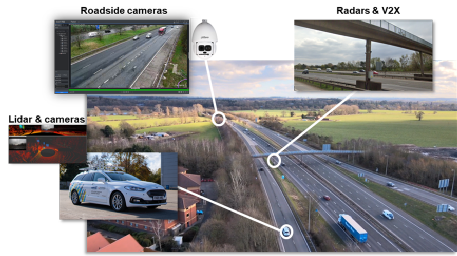 have used a connected smart roadside infrastructure and onboard vehicle systems to demonstrate how to enhance the vision and perception of future autonomous vehicles to achieve safer and more comfortable manoeuvres along high-speed junctions, such as motorway merges.
have used a connected smart roadside infrastructure and onboard vehicle systems to demonstrate how to enhance the vision and perception of future autonomous vehicles to achieve safer and more comfortable manoeuvres along high-speed junctions, such as motorway merges.
The Centre for Connected and Autonomous Vehicles (CCAV) and Innovate UK have jointly funded £2.6m for the collaborative R&D project AutopleX between March 2019 and September 2022.
AutopleX brought together WMG and leading automotive and mobility management partners Jaguar Land Rover (JLR) and Yunex Traffic, as well as public bodies such as Transport for West Midlands (TfWM) and National Highways.
Supported by the WMG Centre High Value Manufacturing Catapult, engineers and researchers at WMG have built a proof-of-concept demonstrator, where technology within a test vehicle (also known as “the EGO vehicle”) including Global Navigation Satellite Systems (GNSS), LiDAR and cameras, was fused with infrastructure-based sensing received over a Vehicle-to-Everything (V2X) communication system. This created a more comprehensive understanding of the environment in which the vehicle was travelling.
Colin Teed, AutopleX Project Manager at Jaguar Land Rover, stressed that: “Merging at high-speed junctions will be a standard action autonomous vehicles must perform and constitutes an important step in realising the vision of connected and automated mobility.”
Professor Mehrdad Dianati, Head of Intelligent Vehicles Research at WMG, added: “Onboard sensors may suffer from several limitations such as occlusions, limited range, and other forms of impairments. Especially at motorway junctions, where the speed of vehicles is usually high, undetected traffic objects by the onboard sensor suite can impose severe threats on safety. Onboard perception can, therefore, become insufficient as a standalone solution for level 4 autonomy. In this regard, the AutopleX project has developed a proof-of-concept solution that combines, in real-time, the onboard perception of a connected vehicle approaching a motorway with infrastructure-based sensing for supporting a safe merge.”
The AutopleX showcase demonstration took place via a live road traffic environment at Junction 15 of the M40 in March 2022. Yunex Traffic developed the roadside perception system, including three radars and V2X communication technology, while National Highways ensured its safe installation and effective operation.
Jet Feng, Project Engineer at WMG, explained: “The roadside perception including the locations, speed and steering angle of motorway vehicles was continuously broadcast (in the form of collective perception messages (CPMs)) and received by the vehicle’s onboard communication unit (OBU) on the Open Innovation Vehicle Platform whilst approaching the merging point of the junction. The received information was then combined with the onboard perception to improve the overall understanding of the environment and was visualised in real-time via a bird’s eye view map of the junction, allowing the passengers to observe road traffic objects along the M40, which were not otherwise visible due to occlusions.”
Furthermore, WMG and Jaguar Land Rover researchers jointly developed intelligent trajectory-planning algorithms, which utilised the combined perception to design a high-speed merging manoeuvre that is efficient, smooth, and safe.
Dr Konstantinos Koufos, Senior Research Fellow at WMG, commented: “While the Open Innovation Vehicle Platform was driven by a human driver, the calculated trajectory, including speed and steering, of a hypothetical vehicle using the combined perception was visualised in real-time on the in-vehicle monitors. This allowed the passengers to compare the trajectory of the hypothetical (or ghost) vehicle with the actual trajectory of the human-driven vehicle. Key performance indicators (KPIs) associated with road safety and passenger comfort were also calculated and compared during the merging manoeuvre. The next major step would be to engage the calculated trajectory of the ghost vehicle with the drive-by-wire system of the Open Innovation Vehicle Platform.”
The project successfully implemented and demonstrated the developed technology, collecting, annotating and processing vast datasets including over eight months of road traffic data using 10 infrastructure cameras and three RADARs. These datasets could be made available to selected organisations outside of the AutopleX consortium for user trials and feedback. In addition, it constitutes valuable R&D data that can be used in WMG’s Doctoral Training Centre in Future Mobility Technologies, as well as WMG’s MSc programme in Smart Connected and Automated Vehicles (SCAV).
Learn more about the vehicle used in the demonstration: https://warwick.ac.uk/fac/sci/wmg/research/cav/ivfac/catapult-open-innovation-vehicle/
Explore research in WMG’s Intelligent Vehicles Group: https://warwick.ac.uk/fac/sci/wmg/research/cav/
Innovate UK: https://www.ukri.org/councils/innovate-uk/
Centre for Connected and Autonomous Vehicles: https://www.gov.uk/government/organisations/centre-for-connected-and-autonomous-vehicles
WMG High Value Manufacturing Catapult:
https://hvm.catapult.org.uk/centre/wmg/
WMG PhD student heads to COP27
A PhD student, from WMG at the University of Warwick, is heading to Egypt this week for COP27.
Shravani Sharma, who is studying for a PhD in Travel Choices and Wellbeing, is heading to the climate summit as the Youth Transport Fellow for High Level Climate Champions UNFCCC, a role centred on building momentum towards an accelerated transition to zero emission vehicles.
Shravani’s work has always focused on the transport sector (which is responsible for a quarter of global greenhouse gas emissions), and on persuading policymakers, operators and the public of the benefits of cleaner and healthier modes of transport supported by evidence-based research and analysis.
She will be sharing her expertise at the “Youth on the move: Young people and transport in the 21st century” session on 10th November and at several other events.
Shravani, who is part of WMG’s Intelligent Vehicles Research Group, explained: "In a world where we are striving to adopt more sustainable forms of transport, it is paramount that our transportation systems and policies are designed to enable modal shift and promote positive travel behaviour.
“I was not even aware that transport planning was a career! I fell into it by accident after taking a module on planning infrastructure and found it not only fascinating, but so rewarding as it impacts the real world and real life. I I grew up watching TV shows about doctors in hospital environments and law firms where the protagonists save the world, which made me want to be a doctor or lawyer coming from an aspirational cultural background. I feel there should be more movies and TV shows made to inspire the upcoming generations to showcase the importance of city and transport planners, and use the power of media for positive drum rolling.
“If our towns and cities are the hearts of the nation, contributing to most of the economic activities, then transport infrastructure is our arteries. Therefore, to ensure good health of the nation we should ensure these arteries are clear of congestion, pollution, accidents etc. “
You can register for ‘Youth on the move: Young people and transport in the 21st century’ here: Youth on the move: Young people and transport in the 21st century (oecd-events.org)
Read more about WMG’s latest sustainability news here: WMG :: News (warwick.ac.uk)
How to move fast (and safe): enabling automated transport by land, sea and air
Dr Siddartha Khastgir, Head of Verification and Validation of Connected and Autonomous Vehicles (CAVs) at WMG at the University of Warwick, is working on a series of workshops to define a universal framework for autonomous vehicle safety that can apply to any mode of transport.
Dr Khastgir’s workshops, in partnership with the Department for Transport and Lloyds Register, focus on identifying the differences and similarities in safety scenarios faced by different sectors to create a cohesive safety framework.
Watch How safe is safe enough? : land, sea and air and read the Cross Domain Safety Assurance Framework for Automated Transport Systems report: to find out more.
University of Warwick wins £1 million grant to help UK get ready for electric vehicles
- The funding will be used to launch a new programme called the Warwick Electrification Deployment (WELD)
- WELD will be contributed to by WMG's Power Electronics, Machines and Drives (PEMD) Group and the School of Engineering's Power Electronics group
- These two world class research groups will use Warwick’s unique facilities, as well as the university’s manufacturing and testing capability to help in the new education programme
- WELD is one of the winners of the ‘Driving the Electric Revolution: Building Talent for the Future 2’ competition, run by Innovate UK
- The new initiative will include industry workshops, outreach activity in school and increased teaching provision within PEMD
New content in power electronics, eMachines and drives will also be created at the University to use current expertise to both up-skill the existing workforce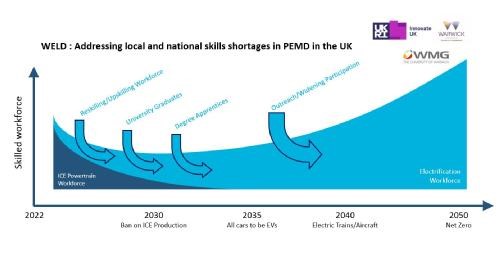 and support the pipeline of talent for future generations.
and support the pipeline of talent for future generations.
Finally, WELD will also focus on the design of IP-free eMachines, with parts manufacture, assembly and testing on campus to allow for hands-on learning.
As both transport and industrial equipment pivots from combustion technology to electrical power, skills for the design, manufacture and maintenance of electric drivetrains are increasingly in demand.
WELD will benefit from the two ‘Driving the Electric Revolution Industrialisation’ (DER-IC) facilities at the university: the Winding Centre of Excellence and the power electronics reliability and failure analysis space, both launching in Autumn 2022. The trained workforce will help UK businesses to develop and scale new PEMD technologies and manufacturing processes.
Dr Juliette Soulard, Associate Professor Electric Machines at WMG says: “Through our close collaboration with UK industry, we witness the huge difficulties faced when trying to recruit people with the right skills for PEMD research and development projects.
“The expertise exists in the UK, but the knowledge and skills transfer needs dedicated and urgent actions which normal higher education courses cannot deliver. WELD’s industry workshops with unique, hands-on learning about manufacturing and device testing aims to address this issue.”
Prof. Peter Gammon, Professor of Power Electronic Devices, Head of Research and Deputy Head of the School of Engineering says: “We are extremely proud to be leading the WELD project, which will help meet a national and international PEMD skills shortage.
“Our activities will also help increase the flow of engineering graduates into the industry via new PEMD and Automotive Electrification MScs, while an extensive outreach programme will help educate and inspire the next generation of engineers.”
ENDS
Note to Editors:
Useful Links:
Driving the Electric Revolution - Industrialisation Centres
WMG, University of Warwick
WMG is a world leading research and education group, transforming organisations and driving innovation through a unique combination of collaborative research and development, and pioneering education programmes. As an international role model for successful partnerships between academia and the private and public sectors, WMG develops advancements nationally and globally, in applied science, technology and engineering, to deliver real impact to economic growth, society and the environment.
WMG is one of the founding partners of the High Value Manufacturing (HVM) Catapult and leads HVM Catapult activities on Transport Electrification and Connected and Autonomous Mobility. The Catapult network’s mission is to leverage research and educational expertise to de-risk innovation for UK manufacturing, to improve business resilience, productivity, competitiveness and sustainability.
School of Engineering, University of Warwick
The School of Engineering benefits from its multidisciplinary approach, with research covering a broad range of topics. Key themes of Energy, Biomedical Engineering, and Future Cities, Materials and Manufacturing, and Technology and Society provide a framework to the research efforts, which are underpinned by four discipline streams and fourteen research groups. The School employs some of the leading engineers in their field, who regularly publish papers in top ranking journals. There are currently over 150 students undertaking postgraduate research degrees and 55 65 research post-doctorate staff.
DER-IC
DER-IC (Driving the Electric Revolution Industrial Centres) is building a globally recognised, sustainable UK-wide network with the relevant skills and capabilities to deliver the PEMD (power electronics, machines, and drives) necessary for a net zero future in all relevant applications. The network of DER-IC is instrumental in the UK’s progress towards its 2050 net zero target and a world leading response to the realisation of the industrial technology (IDT) revolution.
DER-IC is funded by UK Research and Innovation and was set up in 2020 as part of the Driving the Electric Revolution challenge.
DER-IC provides open access facilities to over £300 million worth of state-of-the-art equipment, bringing together the UK’s technology and manufacturing expertise in electrification research and development.
§ DER-IC is creating cost-effective, UK-based technologies and solutions, with export market opportunities, to help address and support climate change
§ DER-IC is educating about the art of what’s possible for governments, industry, academia, and schools
§ DER-IC is an industry led project which has so far engaged with 400 industrial organisations, as well as having 30+ academic institutions and RTO’s in its network
WMG welcomes guests from UTeM Malaysia
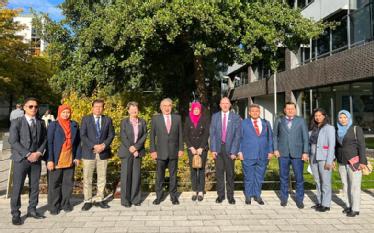 It was a pleasure to welcome guests from the Universiti Teknikal Malaysia Melaka (UTeM) to WMG at the University of Warwick on Wednesday 12th October 2022.
It was a pleasure to welcome guests from the Universiti Teknikal Malaysia Melaka (UTeM) to WMG at the University of Warwick on Wednesday 12th October 2022.
UTeM Chancellor cum Melaka State Governor, His Excellency Tun Seri Dr Mohd Ali Mohd Rustam; UTeM’s Vice Chancellor, Professor Dr Massila Kamalrudin; and UTeM’s Deputy Vice Chancellor (Research & Innovation) Professor Dr Ghazali Omar; were met by Dean of WMG Professor Robin Clark, University of Warwick Provost, Professor Christine Ennew; and WMG’s Director of Client and Business Development (East Asia) Dr Kogi Balakrishnan,
His Excellency was particularly interested to hear more about WMG’s research addressing net zero including energy innovation, very light rail, smart cities and the future of engineering.
The guests were then given a guided tour of WMG’s world class battery research facilities in the Energy Innovation Centre (EIC), before being given a demonstration of the 3xD Simulator in the International Manufacturing Centre, the world's first immersive, simulated environment for smart and connected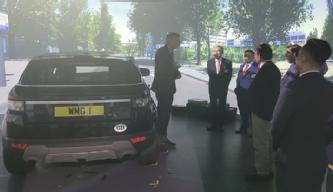 vehicles.
vehicles.
Finally, the delegation was taken to WMG’s Centre for Imaging, Metrology and Additive Technologies (CiMAT) where the group learnt more about scanning technologies for the 3D characterisation and validation of complex internal and external architectures, including high resolution laser scanning, micro-CT and advanced 3D visualisation.
Professor Robin Clark, Dean of WMG at the University of Warwick said: “It was a pleasure to welcome our guests from UTeM and to share the work we are doing here at WMG. What became apparent at the outset was the synergy between the two institutions with respect to the applied way in which we both view our work, whether education or research. I look forward to further discussions and I hope some form of future collaboration.”
His Excellency Tun Seri Dr Mohd Ali Mohd Rustam said: “In line with UTeM’s vision and mission, it is hoping that WMG and UTeM can start fostering collaborations in research and training. WMG’s broad experience and innovation output may lead UTeM to become the leading innovative and creative technical university in the region. Gratitude to WMG for the warm welcome and hospitality during UTeM’s visit to WMG.”
UTeM was established in December 2000, and boasts strengths in technical fields – namely Engineering, IT, and Management Technology. UTeM has cemented a reputation of being a source of high-quality engineering graduates with the capability of meeting the requirements of high-tech industries.
Find out more about UTeM here.
WMG and IIT Kharagpur agree new education and research partnership
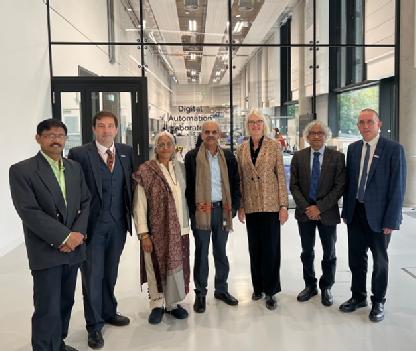 It was an honour to welcome representatives from the Indian Institute of Technology (IIT) Kharagpur to WMG at the University of Warwick.
It was an honour to welcome representatives from the Indian Institute of Technology (IIT) Kharagpur to WMG at the University of Warwick.
The guests were met by Professor Robin Clark, Dean of WMG; Margot James, Executive Chair; Professor David Greenwood, Director for Industrial Engagement and Professor Mark Williams, Chair of the International Strategy Group (ISG). The group was then taken on a guided tour of WMG’s world class research and education facilities in the Professor Lord Bhattacharyya Building, the International Manufacturing Centre (IMC) and the Energy Innovation Centre (EIC).
Guests from the IIT included Professor Virendra Kumar Tewari; Debashish Chakravarty, Professor of Mining Engineering and Associate Dean Alumni Affairs; and Surjya Kanta Pal, Professor of Mechanical Engineering and Chair of the Centre of Excellence in Advanced Manufacturing Technology.
After the tour, Professor Robin Clark and Professor Virendra Kumar Tewari signed a Memorandum of Understanding (MoU) for a further 5 years.
WMG has had a close relationship for many years with the IIT, particularly with IIT Kharagpur and signed the first MoU education and research partnership in 2008.
Following the success of the partnership through the internship and PhD scholarship programme, the two organisations will now continue to work together on research and explore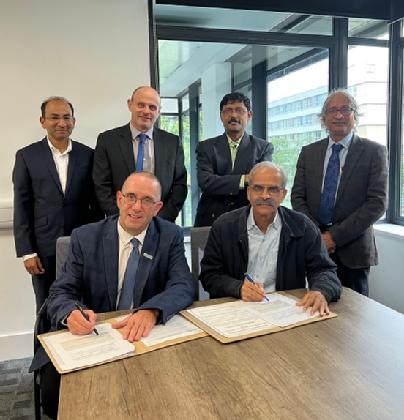 opportunities for a joint PhD programme and joint academic programmes for industry professionals and academic staff in the field of automation, manufacturing, and Industry 4.0. The relationship will also facilitate the exchange of staff between the two institutions and develop a joint PhD programme.
opportunities for a joint PhD programme and joint academic programmes for industry professionals and academic staff in the field of automation, manufacturing, and Industry 4.0. The relationship will also facilitate the exchange of staff between the two institutions and develop a joint PhD programme.
Professor Robin Clark, Dean of WMG at the University of Warwick said: “It was a pleasure to welcome colleagues from IIT Kharagpur, to hear about their work and to share what we are currently engaged in at WMG. Our relationship is long standing, one that we value highly and one that we are excited about developing with new ideas alongside our established successes.”
Professor Mark Williams, Leader of the Centre for Imaging, Metrology, and Additive Technology (CiMAT) said: “The extension of this important partnership clearly demonstrates our commitment to a close working relationship with India and builds on the international presence of WMG and The University of Warwick.”
Professor Virendra K Tewari, Director, IIT Kharagpur remarked: “It was a pleasure to visit the University of Warwick. A warm welcome was extended by our counterparts which gave us many memoirs to cherish. We look forward to further great associations and collaborations with WMG in terms of innovative ideations on academic frontiers and explore other opportunities of research and development. These understandings will enhance the scope of technological advancements for both the institutions and carve a way for better successes.”
Visit the ‘Overseas Teaching Centres’ webpage for more information about WMG’s collaborations with international institutions.
